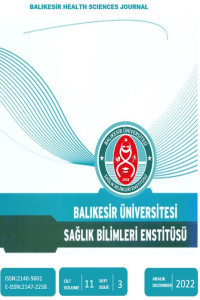ÜNİVERSİTE ÖĞRENCİLERİNİN “PIERCING”E YÖNELİK BİLGİ VE TUTUMLARI
Vücut piercingi, Komplikasyonlar, Tutum, Üniversiteler
KNOWLEDGE AND ATTITUDE OF UNDERGRADUATES ORIENTED “PIERCING
Body piercing, Complications, Attitude, Universities,
___
- 1. Spears RA (Editor in chief). NTC’s American English learner’s dictionary: The essential vocabulary of American language and culture. NTC Publishing Group. 1st Edition, United States of America, 1998: 669.
- 2. Hogan L, Armstrong ML. Body Piercing: More than skin deep. Skin Therapy Letter. 2009; 14: 4-8.
- 3. Kaatz M, Elsner P, Bauer A. Body-modifying concepts and dermatologic problems: tattooing and piercing. Clin Dermatol 2008; 26: 35–44. doi:10.1016/j.clindermatol.2007.10.004
- 4. Mesleki Yeterlilik Kurumu. “Dövmeci ve Takı Takma (Piercing) Sanatçısı (Seviye 3) Meslek Standardı”. http://www.tesk.org.tr/tr/mevzuat/dovme3.pdf Erişim tarihi: 18/07/2012.
- 5. Larkin BG. The ins and outs of body piercing: Home study program. AORN J 2004; 79: 333-343.
- 6. Schmidt RM, Armstrong ML, Middleman AB, Torchia MM. “Body piercing in adolescents and young adults”. http://www.uptodate.com/contents/body-piercing-in-adolescents-and-young-adults Erişim tarihi: 30/07/2012.
- 7. Stirn A, Çev: Çayır A. Piercing medikal sonuçları ve psikolojik motivasyonları. Literatür. 2003; 38: 337-355.
- 8. Gunter TE, McDowell BM. Ask the expert, body piercing: issues in adolescent health. Spec Pediatr Nurs. 2004; 9: 67-69.
- 9. Davis D. “Tattoos and Body Piercing - The Longevity of An Ancient Trend”. Honors College Theses, New York: Pace University, 2005. http://digitalcommons.pace.edu/honorscollege_theses/10 Erişim tarihi: 01/08/2012.
- 10. Stieger S, Pietschnig J, Kastner CK, Voracek M, Swami V. Prevalence and acceptance of tattoos and piercings: a survey of young adults from the southern German-speaking area of Central Europe. Percept Mot Skills 2010; 110: 1065-1074.
- 11. The Victorian Government (Department of justice) discussion paper, summary offences amendment (tattooing and body piercing) Bill exposure draft. Prevalence of body piercing and tattooing, January 2008: 5.
- 12. Meltzer DI. Complications of body piercing. Am Fam Physician 2005; 72: 2029-2034.
- 13. Hellard M, Aitken C, Ridge A, Bowden S. Investigation of infection control practices and knowledge of hepatitis C among body-piercing practitioners. Am J Infect Control 2003; 31: 215-20.
- 14. Oberdorfer A, Wiggers JH, Bowman J, et al. Moitoring and educational feedback to improve the compliance of tattooists and body piercers with infection control standards: a randomized controlled trial. Am J Infect Control 2004; 32: 147-154.
- 15. Stirn A, Oddo S, Peregrinova L, Philipp S, Hinz A. Motivations for body piercings and tattoos — The role of sexual abuse and the frequency of body modifications. Psychiatry Res 2011; 190: 359–363. doi:10.1016/j.psychres.2011.06.001
- 16. Esen IU. Body piercing: a growing problem for clinicians. Hosp Med 2004; 65: 86-87.
- 17. Esen UI, Orife S. Penile jewellery: a cause of post-coital bleeding. Gynaecology Case Reports 2005; 483-484.
- 18. Aksakoğlu G. Araştırma Planlama ve Çözümleme. 2. Yazım, İzmir: Dokuz Eylül Üniversitesi Basımevi, 2006: 100-235.
- 19. Quaranta A, Napoli C, Fasano F, et al. Body piercing and tattoos: a survey on young adults' knowledge of the risks and practices in body art. BMC Public Health 2011; 11: 1-8. PMID: 21981772.
- 20. Mayers LB, Chiffriller SH. Body art (body piercing and tattooing) among undergraduate university students: "then and now". J Adolesc Health. 2008; 42: 201-3.
- 21. Carroll ST, Riffenburgh RH, Roberts TA, Myhre EB. Tattoos and body piercings as indicators of adolescent risk-taking behaviors. Pediatrics 2002; 109: 1021– 1027.
- 22. Hayes MO, Harkness GA. Body piercing as a risk factor for viral epatitis: an integrative research review. Am J Infect Control 2001; 29: 271-74.
- 23. Nowosielski K, Sipiński A, Kuczerawy I, Kozłowska-Rup D, Skrzypulec-Plinta V. Tattoos, Piercing, and sexual behaviors in young adults. J Sex Med. 2012; 22. doi: 10.1111/j.1743-6109.2012.02791.x.
- 24. Huxley C, Grogan S. Tattooing, piercing, healthy behaviours and health value, J Health Psychol 2005; 10: 831-841.
- 25. “Tattooing and body piercing: Decisions for teens”. http://www.vh.org/ navigation/vch/bibliography/archive. Erişim tarihi: 15/09/2007.
- 26. Cegolon L, Miatto E, Bortolotto M, et al. VAHP Working group. Body piercing and tattoo: awareness of health related risks among 4,277 Italian secondary school adolescents. BMC Public Health 2010; 10: 1-8. PMID: 20163712.
- ISSN: 2146-9601
- Yayın Aralığı: Yılda 3 Sayı
- Başlangıç: 2012
- Yayıncı: Balıkesir Üniversitesi
HİPERTANSİYONLU BİREYLERDE TAMAMLAYICI VE ALTERNATİF TEDAVİ KULLANMA DURUMU
Şefika Dilek GÜVEN, Gamze MUZ, Nuriye Efe ERTÜRK, Ayşegül ÖZCAN
HEMŞİRELİKTE ELEŞTİREL DÜŞÜNMENİN KLİNİK KARAR VERMEYE ETKİSİ
PERİODONTAL HASTALIKTA YAŞLILIK İLE KEMİK MARKIRLARININ İLİŞKİSİ
Sabri Fatih KURŞUNLU, Veli Özgen ÖZTÜRK
SAĞLIK ÇALIŞANLARININ SAĞLIĞI VE GÜVENLİĞİ
Ayşe Meydanlioğlu AYŞE MEYDANLIOĞLU
İNTRAPANKREATİK LİPOM: GÖRÜNTÜLEME BULGULARI
Erdoğan BÜLBÜL, Bahar YANIK KEYİK, Murat YILDAR, Gülen DEMİRPOLAT, Bahri KEYİK
YAŞLI BiREYLERDE DiŞETi OLUĞU SIVISI OSTEOKALSiN SEViYESiNiN DEĞERLENDiRiLMESi
Sabri Fatih KURŞUNLU, Veli Özgen ÖZTÜRK, Mehmet Zahit BAŞ
ERKEĞİN KADINA YÖNELİK ŞİDDETE BAKIŞI VE TUTUMU
A Gökçe DEMİR, Gizem Deniz BULUCU, Ayşegül ÖZCAN
HEMŞİRELERİN İŞ YAŞAMI KALİTELERİ İLE HASTA MEMNUNİYETİ ARASINDAKİ İLİŞKİNİN İNCELENMESİ
Ruşen ÖZTÜRK, Duygu GÜLEÇ, Sezer ER GÜNERİ, Ümran SEVİL, Nalan GÜRMEN
ÜNİVERSİTE ÖĞRENCİLERİNİN “PIERCING”E YÖNELİK BİLGİ VE TUTUMLARI
Dilek Çakır UMAR, Filiz ÖĞCE, Yeliz Çakır KOÇAK, Zehra BAYKAL AKMEŞE
